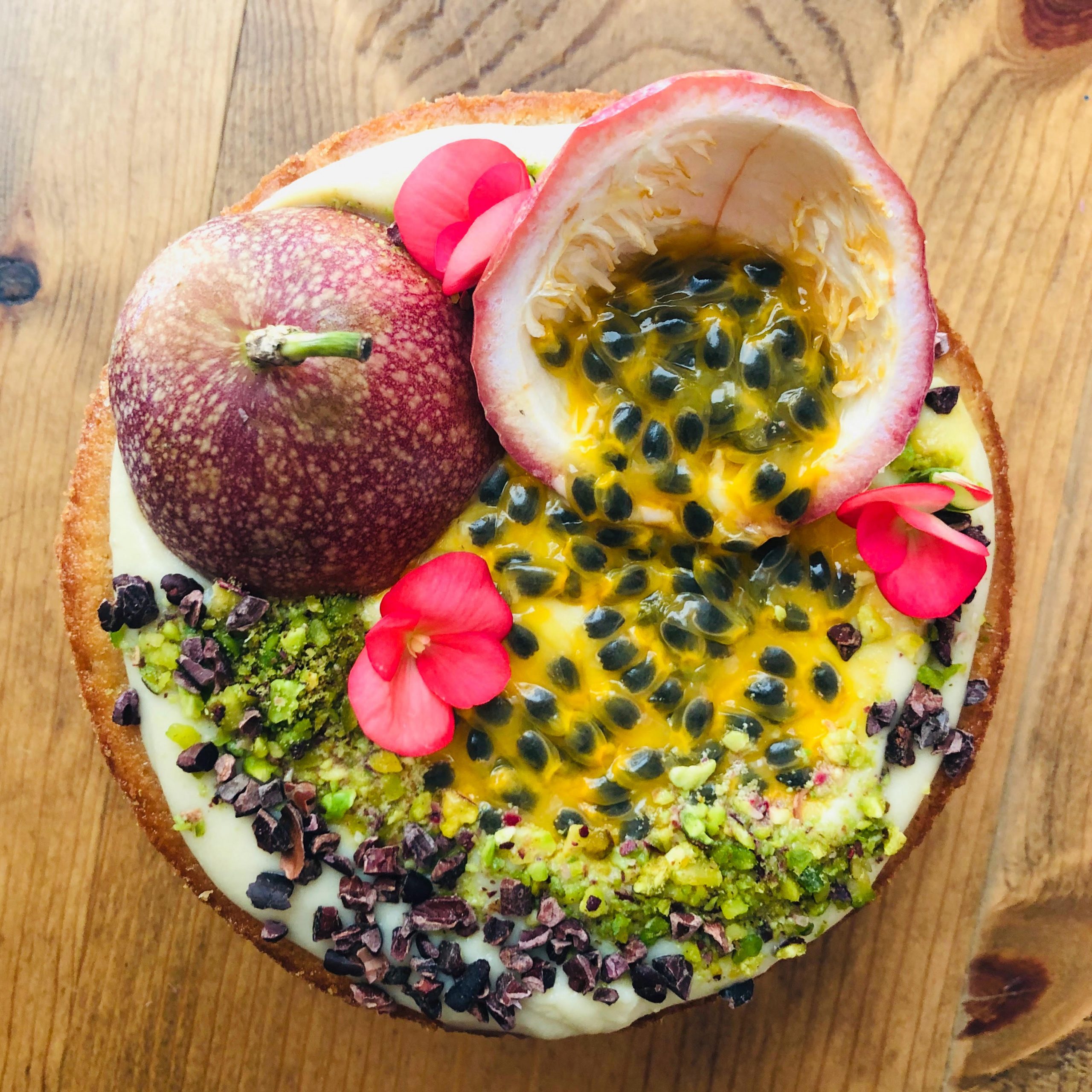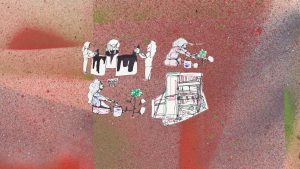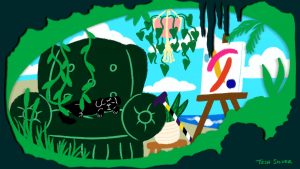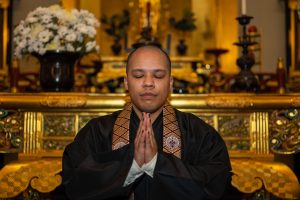Joey Pham is “the cake zaddy, tarot reader, and spiritual coach behind Flavor Supreme. Their different, but interconnected mediums are ways they have conversations around sustainability and spirituality.” I was introduced to their baking in 2019, when a dear friend called me and told me to clear my calendar for a specific date, two months in the future, because she would be bringing over a butternut squash cake with orange curd, pepitas, thyme, and edible flowers made by Joey Pham. We centered a joyful afternoon around that amazing cake, and I loved the way that all of it felt like so much more than just cake as a treat. It was a date, an experience, and special occasion. The cake was so clearly full of love and intention. I started following @flavorsupreme on Instagram and have been both educated and delighted by their work continually since. In this interview conducted over emails, Joey and I discuss their inspirations and approach, magical connections, values, and how they cultivate the perfect energy for creating. Gratitude to Joey for providing this window into their practice.
Carrie Kaufman: Thank you so much for taking the time to share about your work. I am so excited to be doing this interview because, selfishly, I’ve been wanting to ask you so many different questions about the work you do and the art you create ever since I first learned about you! I wanted to start by asking about your creative process when it comes to cakes. How do you get from inspiration to layers and harmony? Where do you usually draw flavor inspiration from when you are creating and baking new cakes?
Joey Pham: Thank you so much for your kind words! I definitely draw a lot of inspiration from nature, the seasons, savory foods, herbs, memories, feelings, and Magick.
CK: What savory flavors and components are you excited to work with this spring and summer?
JP: I love working with fresh herbs. They are usually thought of as savory components, but adding tarragon or thyme to strawberries adds another dimension of flavor. The things I love most about spring and summer, aside from sunshine and glowing skin, are the variety of fruits that are in season. I can’t wait to work with plums, cherries, blueberries, peaches, apricots, and pair them with herbs and some salty notes. Fresh flowers are beautiful and inspiring, too.
CK: What’s an example of a cake you based on a memory or feeling? I love that.
JP: I recently made a brown butter cake with vanilla bean Swiss buttercream, bruleed pears, smoked pecans, and sage. I wanted to curate an entire experience for cake recipients and immerse them in warmth, since I was making this during a very cold period. The flavors elicit comfort, while the sage was cross-utilized. Some of it could be enjoyed on the cake, steeped as a tea, or added to a bath to round out the experience. I love adding components where people can pluck off some ingredients to brew a tea to enjoy with the cake, or make a whole event of it; where they can enjoy some cake in a bath by candlelight with their favorite music on. It’s how I like to enjoy cake, and I invite others to fully embrace the experience.
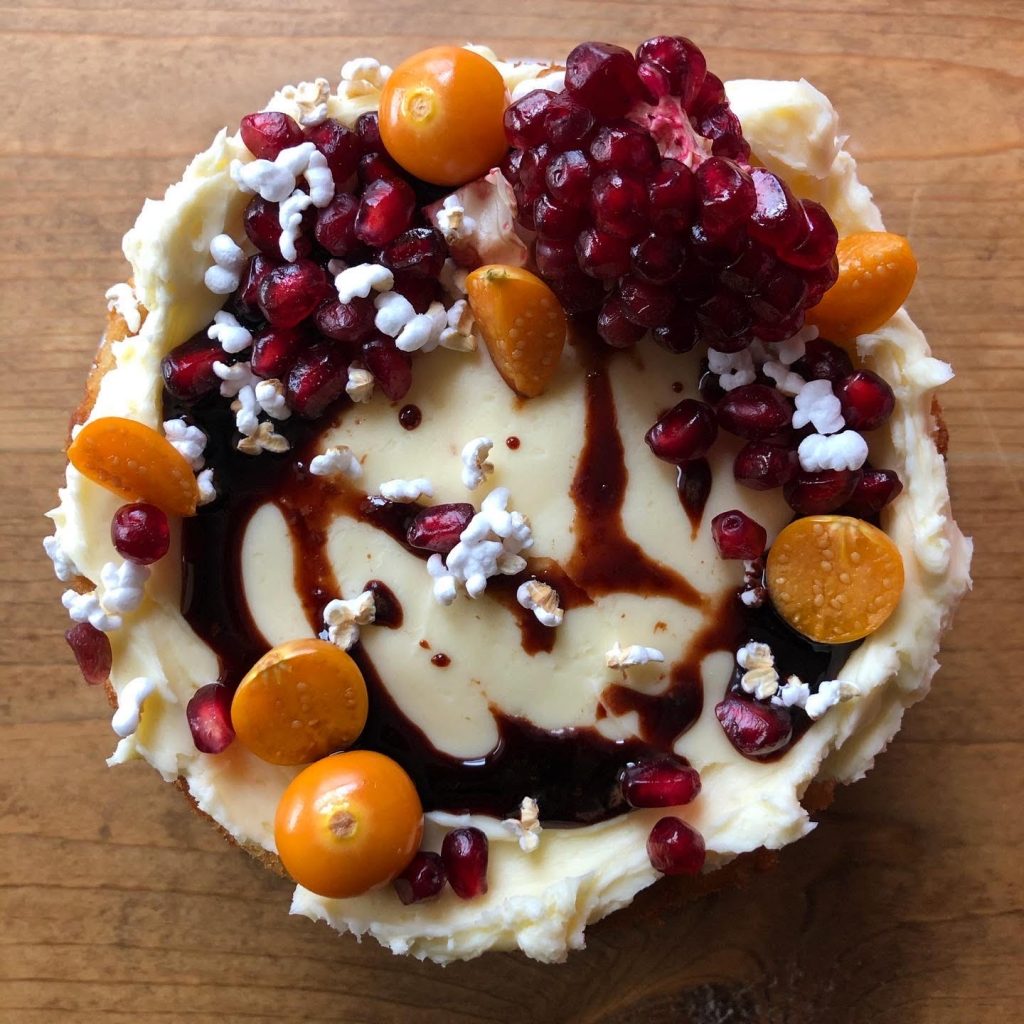
CK: Do the ingredients in your cakes affect the way you choose to present and decorate each specific cake?
JP: Absolutely. I try my best to center and highlight seasonal ingredients, and they inform a lot of the creations. Oftentimes, I’ll be at a grocery store or the farmer’s market, see an ingredient I haven’t featured in a cake, and I’ll get it on the spot and work with it. I study herbalism, which I infuse in certain cakes, and hope that they bring healing to those who get them. This practice allows me to see food in a new light and express appreciation and gratitude for nature’s bounty.
CK: Nature has so much to give and teach us! What was in the last cake you made that incorporated your herbal and healing wisdom? Can people request this type of cake?
JP: The last cake that incorporated some herbal inspiration was a ginger cake, with black tea cream, hibiscus, mandarin oranges, and bee pollen. I’ve been healing my heart and wanted to feature hibiscus in an approachable way since it literally facilitates heart function. It was perfect. They certainly can request this type of cake. Others have in the past. I’m working on a way to incorporate herbalism into cakes and make that a more visible option for people who are seeking some healing.
CK: Do you use the term “artist” to describe yourself?
JP: Sure. Everyone is an artist, though. Everyone transmutes energy into a medium, or several different mediums, and brings forth things in the world that asks others to do the same.
CK: Do you listen to any particular music or podcasts when you’re baking and decorating? What other things help nurture your creative process?
JP: I listen to podcasts all day long while I’m baking! Since so much of it is muscle memory, I get to be in my head and process the conversations that occur in podcasts. Some of my favorites are: Feeling Asian, What’s Your Sign?, Millennial Soul Food, Rise Up! Good Witch, Ghost of a Podcast, and Pop Culture Happy Hour, just to name a few. All of these podcasts deepen my understanding of myself and therefore the world. I hope folks can feel the laughter, thoughtfulness, healing, and magic I process and channel into cakes.
CK: Thank you for sharing this list! Are there any other rituals, routines, or energies that support your baking process?
JP: I make my own cleansing bundles and smoke cleanse/bless the ingredients I use. I want to make sure the vibration I’m putting out there is right.
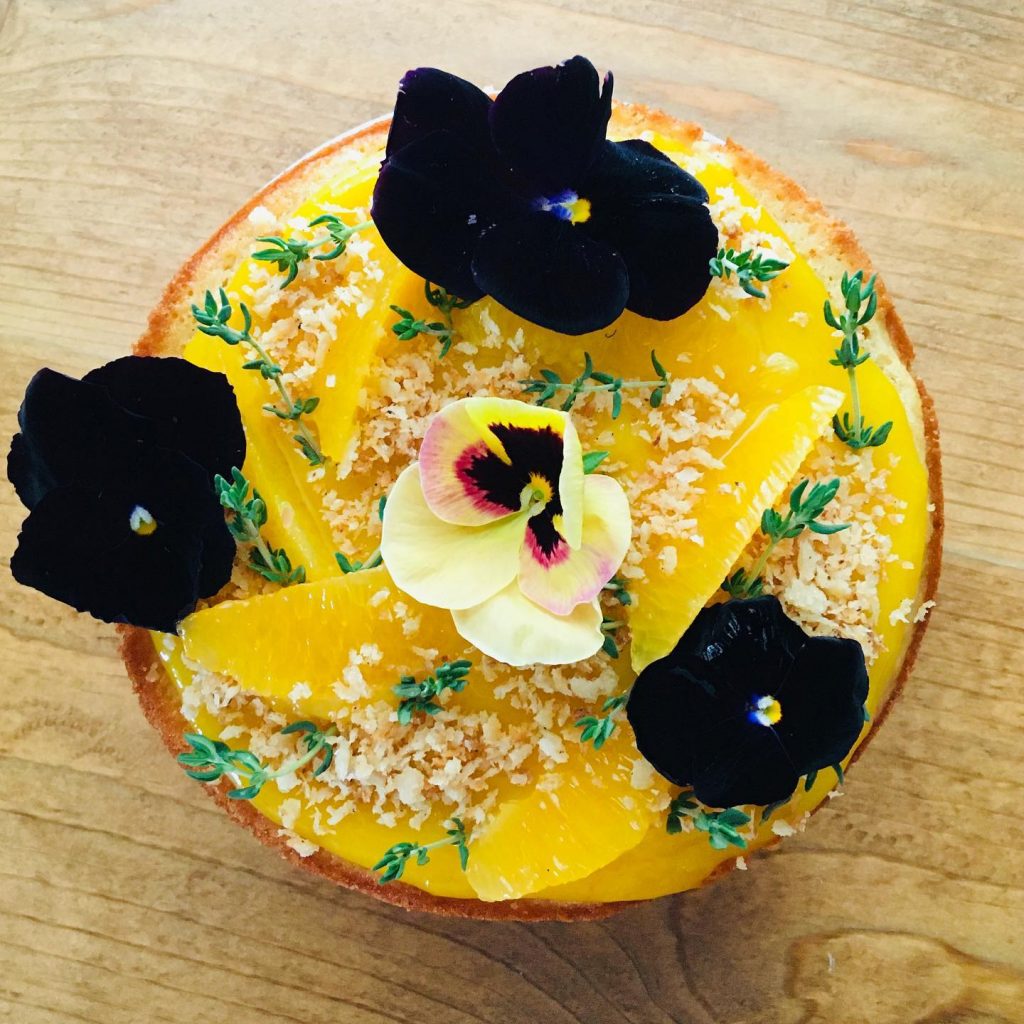
CK: You don’t cook with chocolate for ethical reasons. Could you share more about this practice and why it is important to you?
JP: In college, I took a life-altering humanities class where we focused on Nestle’s exploitative chocolate farming practices. A lot of light was shed on the history of Indigenous foods that are now commodified, and it led me on the path to personally studying and supporting sustainable agriculture–not just for Earth’s sake, but for laborers first and foremost. By refusing to work with chocolate, I lessen the demand for it, and initiate conversation about where it comes from, our relationship to it, and the actual costs of its production. It is a sacred food that deserves honoring, and pre-industrialization, it was not made for everyday consumption. To bury it in a plethora of other ingredients in a cake would be thoughtless of me. I only specialize in particular things, and chocolate is not one of them. I don’t have the proper education or resources to provide others with high-quality, ethically-produced, fair trade chocolate, so I don’t work with it at all. I leave this up to the folks who have a deeper connection with it.
CK: You’ve also raised a lot of awareness around equitable labor practices in food service. Can you explain your fair living fee, and the reasons that you don’t rely on tips for your delivery drivers?
JP: I am slowly implementing the changes I’ve always wanted to see in the food industry, in the ways that I know how. It is a process. I prioritize fair wages, work/life balance, and ethical labor, so I put into effect mindful businesses practices that look a bit different than what we’ve come to know. The Fair Living Fee is in place because I want to practice transparency and feature the importance of every job, and how everyone in the process deserves a livable wage, not just the person at the “top.” The tipping system, rooted in slavery and racism, was created to pass the responsibility of the server’s wage in the hands of the consumer rather than the employer, leaving them vulnerable to unreliability of pay and discrimination. This is unethical. In my business, I clearly state how much of each sale the person who delivers receives, which is $20/hour. Honestly, I wish this was more! It’s my responsibility and privilege to radicalize my relationship to money, and share this with those around me. There is enough for everyone, and I envision a life where money is regarded for what it really is–a tool used to get what we need out of abundance rather than scarcity.
CK: My next question is inspired by one of your Instagram story posts, a meme about not going back to so-called normal because, now, you are focusing on the eight new jobs you created for yourself during quarantine. This is relatable! What are some of the projects that have been really nourishing and exciting for you to work on over these past 12 months? And what new paces and ideas are you looking forward to stewarding into the future?
JP: I’ve been working with my spiritual teacher for the past five years, who has encouraged me to step into spiritual work since the very beginning. Our work together is the strongest foundation in my life’s path, personally and professionally. I was terrified of this step in my life, and didn’t consciously move forward with it until a few months ago. Something clicked when I began offering tarot readings, and realized what I was channeling was the same energy/words I offer in other modalities of healing. To solidify my education and practices, I’ve been taking classes and studying as much as I can to bring intentionality and mindfulness to clients. I now offer different modalities, which include spiritual coaching, reiki, and tarot. This list will grow as I undergo more training and experience. So much of this work reflects on how I approach cake making, and it all takes me as far as I want to grow.
CK: This is so exciting. Your spiritual teacher sounds really special, and I love that you named growth in the context of your classes and study. Spiritual growth in particular to me feels like root growth and also branches, reaching in every direction. Is there anything in particular that has been deepening or blossoming for you?
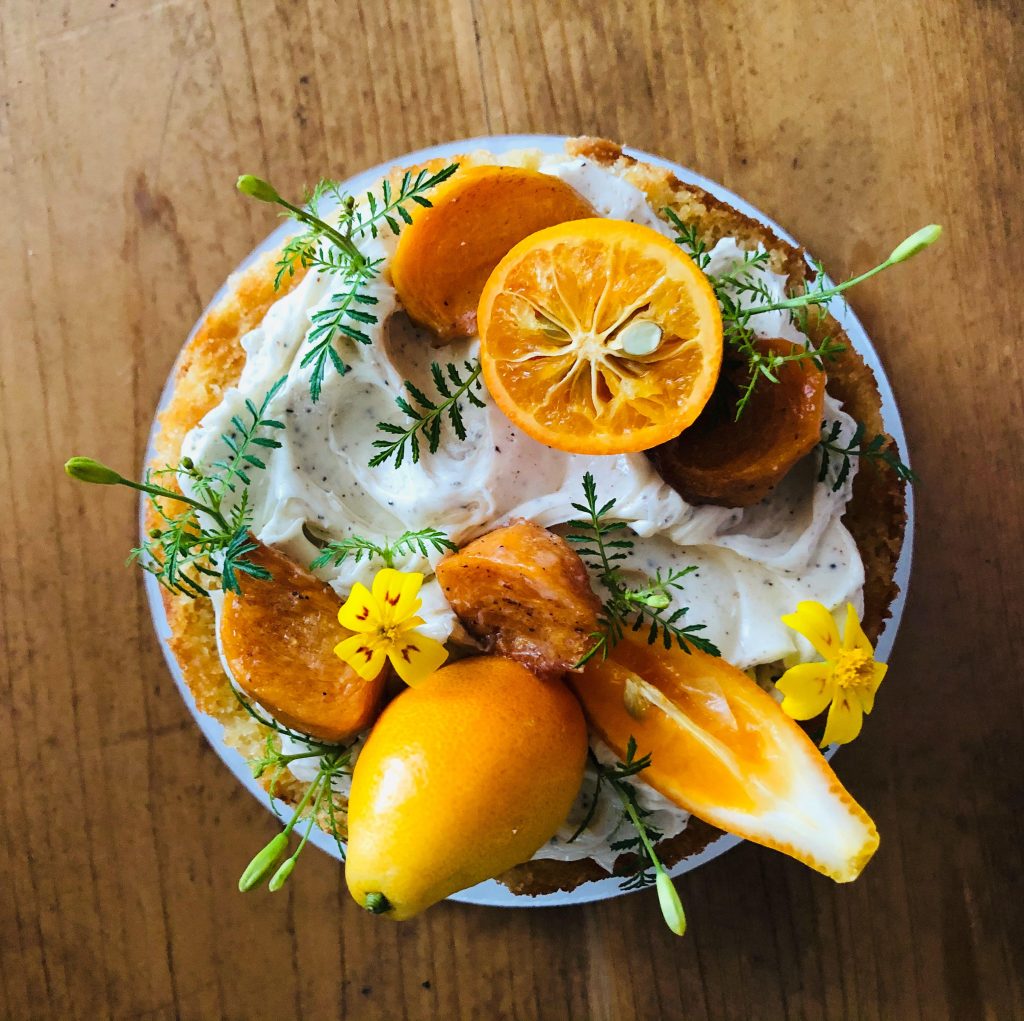
JP: That’s such a beautiful way to put it, and I totally agree. What guides me in this work, cake and spiritual, is focusing on what I do have control over–where my power is, rather than where I don’t have control. I often get enraged by injustices and oppressive structures, and it teaches me a lot about what I can do, what is within reach, and what I really want to say and put forth in the world. I feed the vision of what I want to see, and I let the things I disagree with guide me on how to get there because those are mistakes I don’t have to make for myself, and structures/rules I don’t have to abide by.
CK: You’ve worked previously in the field of sex education, which on the surface seems like something that is unrelated to baking cakes or reading tarot. For me, creating, cooking, and eating food can all be very sensual and be erotic processes and experiences. I personally see a lot of connection between sex education, healing work, and baking and sharing food. I’m wondering if you can talk a little bit about any common threads in the work you do or have done.
JP: You’re so right. Sex and food are both very sensual, and embody pleasures of this world. I’ve centered my work around both for many reasons, as they are all ways I channel Spirit/Source. When I worked in sex education, I specialized in BDSM and often connected it to energy work and spirituality. For me, the magic is where sensations leave me suspended in time, allowing me to be present with the depth of the experience. This applies to sex and food just as much as it does healing. Tapping into sexual energy can be so visceral, it can shift the energy of oneself (and the room), which is something that food does, and the same goes for tarot and reiki. These are all different methods of channeling energy and spiritual nourishment. What pulls me in about all of these mediums is how far I can go–and when I come back, I am always changed, humbled, curious, and in awe.
CK: So much yes to change, humility, curiosity, and awe as responses to our bodies, our sexuality, our connection to the divine. Thank you for the reminders in this interview and in your work, to center pleasure and wholeness in our experiences of ourselves and the world. Here’s to seeing how far we can go. Is there anything else you wanted to share?
JP: Thank you so much for giving me the opportunity to speak and reflect with you. In everything that I do, I don’t necessarily want to center myself, but rather, be an instrument in channeling the divine. Everyone is capable of this, and I want to embody a mirror to reflect the possibilities.
Featured image: Vanilla cake, rum-kissed pastry cream, passion fruit, pistachios, cacao nibs, and flowers. Photo by Joey Pham.
carrie sarah kaufman is a queer, multiply disabled, white, Jewish femme. she is a kitchen witch, a plant mama, an artist and survivor. cooking, ritual and poetry are her current tools for connection and healing. her work explores disabled embodiment, sexuality and intimacy as well as themes in Jewish magic and spirituality.
